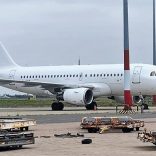Mozambique: New road tolls take effect - AIM report
Mozambique: Port of Maputo wants to invest in rail transport, which has already grown 8% in 2023

Photo: Lusa
More than 1,500 trucks serve the port of Maputo every day, but the administration wants to invest in rail transport, which grew by 8% in 2023, despite an expected prevalence of road transport remaining.
In an interview with Lusa, the executive director of the Maputo Port Development Company (MPDC), Osório Lucas, explained that, currently, 64% of the cargo handled by the port is transported by trucks and the remainder by rail, predominantly exports from southern Africa.
“I’m not so sure [why] it’s so little exploited. Last year there was growth of almost 8%, from one year to the next. That made around eight, nine million tons on the railway line. There is a lot of work to do, that is true, and this has to do not only with CFM [Caminhos de Ferro de Moçambique], but also with the South African railway operator,” he observed.
The goal is to move in the coming years to a ratio of 55% road and 45% rail, but maintaining the road trend. “We will not be able to avoid this, especially because the biggest growth expected in the port is the container terminal, from the current 270,000 in the final investment phase [ongoing until 2058], to one million containers. And it is very likely that many of these containers will come by road,” Lucas said
Even so, he asserts that the “goal is to remove some of the ore [exported by South Africa via Maputo] from the road to the railway line.” “But this is not a process that can be done overnight,” he warns.
He added that CFM and the port of Maputo are finalizing a Railway-Port Master Plan and that the two companies will integrate their respective systems.
“We will have visibility of all railway circulation within Mozambican territory, starting in the next 15 days. This will be a fundamental change. And then we will both enter into negotiations with South African operators in order to guarantee even greater visibility in the system. This will allow for better resource management, which I believe will promote an increase in capacity on the railway,” Lucas says.
Still, he insists that the growth in rail cargo at the port of Maputo has not happened “at the expense of the increase in road cargo”.
“Therefore, if rail cargo grew by 8%, road cargo grew by double digits. And it is this scenario that we have been observing,” the executive director of MPDC acknowledged, citing this as an example of public-private partnership, with the state and private individuals “working in an integrated manner”.
The Port of Maputo Development Society is a private Mozambican company resulting from a partnership between Caminhos de Ferro de Moçambique (CFM) and Portus Indico, which is made up of Grindrod, DP World and the Mozambique Gestores.
The Maputo port concessionaire plans to double the volume of cargo handled annually by 2058, with the scale of the contract and global investments during this period standing at US$2,060 million (€1,900 million).













Leave a Reply
Be the First to Comment!
You must be logged in to post a comment.
You must be logged in to post a comment.